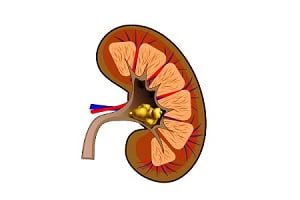Overview
Diabetes can cause long-term complications throughout your body, especially if your sugar levels are uncontrollable and remain elevated for many years. Elevated blood sugar levels can cause diabetic neuropathy, which damages the nerves that transfer signals from your hands and feet. Diabetic neuropathy often presents symptoms like numbness, tingling or pain (diabetic nerve pain) in fingers, toes, hands, and feet.
Approximately 20 million people in the United States suffer from some form of peripheral neuropathy. According to the “National Institute of Neurological Disorders and Stroke” more than 100 types of peripheral neuropathy forms have been recognized and each form has its symptoms and prognosis.
Peripheral neuropathy is the most common form of diabetic neuropathy that mostly affects the legs and feet first and then moves to the arms and hands. Diabetic peripheral neuropathy progresses over many years and worsens over time. Some patients suffer from this condition before their diabetes diagnosis. Prolonged diabetes often increases the likelihood of having diabetic neuropathy.
The loss of sensation and other problems associated with diabetic nerve damage makes a patient prone to various skin ulcers (open sores) that can become infected and are difficult to heal. This serious diabetic complication can lead to loss of a foot, a leg or even a life.
Symptoms of Diabetic Peripheral Neuropathy
Peripheral diabetic neuropathy is the most common form of neuropathy in diabetic people and it usually affects nerves present in your feet, legs, hands, and arms. The nerves leading to your feet are the most often affected nerves because they are the longest in your body and there are more of them to be damaged. Some of the common symptoms of diabetic peripheral neuropathy are:
- Numbness, tingling, and pain in the legs, especially during night
- Inability to discern temperatures
- Increased and sometimes alarming sensitivity to touch
- Weakness
- Loss of balance and coordination
- Low reflexes
- Ulcers and infections in the feet
- Bone deformities and joint pain in the feet
The symptoms associated with diabetic peripheral neuropathy can often be monitored by:
- Regular check-up of feet and legs
- Maintaining toenail hygiene
- Preventing foot injury
- Moisturizing your feet
The symptoms of diabetic peripheral neuropathy should be carefully monitored and managed. If left untreated, even minor cuts on the patient’s feet can turn into ulcers and sometimes lead to gangrenous tissue. Gangrenous tissues often require surgery or amputation. One should not let these symptoms go unnoticed.
Causes of Peripheral Diabetic Neuropathy
Peripheral diabetic neuropathy associated nerve damage is more common in patients with poorly managed diabetes. However, it can also occur in diabetic patients who have controlled blood sugar levels.
As diabetic peripheral neuropathy progresses, it affects different nerves of the body and these damaged nerves result in various problems that ultimately encourage the development of ulcers. For example, Bunions or hammertoes are deformities that result from motor neuropathy. These deformities may cause shoes to rub against toes, and then causes sore formation. Due to sensory neuropathy, the patient is unaware that this is happening. Similarly, due to numbness caused by peripheral neuropathy, a patient is unable to sense that he/she has stepped on a small object and hurt his/her skin.
How Can You Prevent Peripheral Diabetic Neuropathy?
Peripheral diabetic neuropathy can be somehow prevented in the following ways:
- Maintaining blood glucose levels within your target range
- Frequent feet checkups at least once a year
- Sharing any suspected diabetic neuropathy signs with your diabetes healthcare team
- Protect your feet from injuries especially if you’ve lost sensation
- Regular feet checkups
Diabetic Nerve Pain and Peripheral Diabetic Neuropathy
Peripheral neuropathy is the most common type of diabetic nerve pain. It usually affects your feet and legs but gradually your hands and arms also get affected and start presenting various symptoms. Some of the symptoms include:
- Numbness of feet and legs
- Inability to distinguish between various temperatures
- Extreme pain and cramps in the affected areas
- Pins and needles, tingling, or burning sensation in the feet, hands, legs and other affected areas
- Balance and coordination problems
- Extreme sensitivity to even the mild touch
- Weakness of muscles
- Loss of reflexes
- Inability to walk
Due to a lack of awareness regarding the outcomes of foot injury, peripheral neuropathy has become one of the biggest concerns associated with diabetes. Breakage of any tissue due to sharp toenails, tight-fitting shoes, or trauma, becomes a potential entry point for bacteria and the chances of infection spreading to the bones increase.
Diabetes has become a leading cause of lower limb amputation in chronic diabetes patients. Therefore, the best way of preventing amputations is early recognition and treatment of minor foot problems in people with peripheral neuropathy.
Leg Pain due to Diabetic Peripheral Neuropathy
Leg pain found in diabetic people may be the result of nerve damage. Nerve damage in diabetics usually occurs if they do not receive treatment or if they fail to maintain their blood sugar levels.
American Diabetes Association suggests that approximately more than thirty million US people are living with diabetes. Some of them are unaware of their condition, which puts them at a higher risk of diabetic complications such as leg pain. Diabetic neuropathy is one of the severe complications of diabetes.
Diabetic neuropathy usually indicates nerve damage. It can occur in different body parts but is most common in the legs and arms. Nerve damage in outer limbs like hands and feet is called diabetic peripheral neuropathy by doctors and is often characterized by numbness, tingling, and pain due to damaged nerves. Diabetics with diabetes-related peripheral neuropathy are at a greater risk of developing serious complications in their outer limbs like feet and legs. These complications may end up in serious injuries or amputations. Treatment for peripheral diabetic neuropathy mostly focuses on reducing the pain and cramping related symptoms. It also helps in slowing down the progression of this serious condition.
Home Remedies
Although medical treatments can help in reducing the pain, there are different measures that a diabetic person can take at home to reduce the effects of diabetic peripheral neuropathy. The following are some options for alleviating diabetic peripheral neuropathy related leg pain at home.
Exercise
Increased physical activity can be beneficial for people with diabetic peripheral neuropathy. Regular and moderate exercises can be helpful in different ways like improved blood flow. Improved blood flow brings important nutrients and oxygen to the affected areas like legs.
Increased physical activity has a very important role in reducing the peripheral neuropathy-related symptoms in diabetic people. Before going for a strict exercise regimen, diabetic patients should speak to their doctor for avoiding any serious health condition.
Diet
Nerve pain can be somehow reduced by maintaining a healthy balanced diet. Also, eating the right foods for controlling blood sugar levels can aid in preventing nerve damage and underlying inflammation.
Diabetic patients with nerve problems should always focus on healthful options that will help keep their blood sugar levels steady. Some beneficial foods in diabetes include:
- Good fats (from olive oil, nuts, or fish)
- Non-starchy vegetables
- Lean proteins
- Complex carbohydrates (from oatmeal or whole-grain pastas and breads)
- Fruits, in moderation
Supplements
Diet alone cannot provide all the essential nutrients for the body. In some cases, supplementing nutrient intake can fulfill the required nutritional gaps. Before going on a supplement diet, people should always talk to their doctor regarding their specific nutritional requirements. Following vitamins and supplements can be useful in diabetic neuropathy:
- Vitamin D
- Vitamin B-12
- Acetyl-L-Carnitine
- Alpha-Lipoic Acid
Quit Smoking
Smoking has a very bad effect on blood circulation. Therefore, quitting smoking can have a positive effect on a person’s overall health. It is suggested that people with diabetic peripheral neuropathy may find relief from their nervous-related issues if they do not smoke.
Other Options
Besides changing lifestyle, a diabetic person may opt for other measures for relieving his/her diabetic complications. Some other measures that may help alleviate the pain are:
- Acupuncture
- Physical therapy
- Massaging outer limbs like legs and feet
- Soaking the feet in warm water, only if there are no wounds
- Trying using a leg cradle at night






